
The glass frogs belong to the amphibian family Centrolenidae, native to the Central American Rainforests. The general background coloration of most glass frogs is primarily lime green, the abdominal skin of some members of this family is transparent and translucent, giving the glass frog its common name. The internal viscera, including the heart, liver, and gastrointestinal tract, are visible through the skin. When active their blood makes them visible; when sleeping most of the blood is concealed in the liver, hiding them. Glass frogs are arboreal, living mainly in trees, feeding on small insects and only coming out for mating season. Their transparency conceals them very effectively when sleeping on a green leaf, as they habitually do. However, climate change and habitat fragmentation has been threatening the survival rates of the family.

The Leptodactylinae are a subfamily of leptodactylid frogs distributed between southern North America and South America to Brazil. Their sister taxon is the clade comprising the Leiuperinae and Paratelmatobiinae.
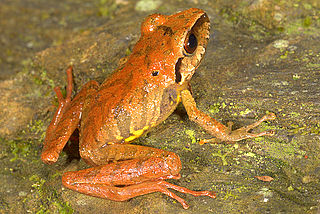
The Eleutherodactylidae are a family of direct-developing frogs native to northern South America, the Caribbean, and southernmost North America. They are sometimes known under the common name rain frogs. Formerly the subfamily Eleutherodactylinae of the family Leptodactylidae, it was raised to the family status following a major revision of New World direct-developing frogs in 2008. As currently defined, the family has more than 200 species.

Physalaemus is a large genus of leptodactylid frogs. These frogs, sometimes known as dwarf frogs or foam frogs, are found in South America. It is very similar to Leptodactylus, a close relative, and indeed the recently described Leptodactylus lauramiriamae is in some aspects intermediate between them.

Leptodactylus is a genus of leptodactylid frogs. It includes the species commonly called ditch frogs or white-lipped frogs. It is very similar to Physalaemus, a close relative, and indeed the 2005 described Leptodactylus lauramiriamae is in some aspects intermediate between them.

Myobatrachidae, commonly known as Australian ground frogs or Australian water frogs, is a family of frogs found in Australia and New Guinea. Members of this family vary greatly in size, from species less than 1.5 cm (0.59 in) long, to the second-largest frog in Australia, the giant barred frog, at 12 cm (4.7 in) in length. The entire family is either terrestrial or aquatic frogs, with no arboreal species.

Leptodactylus macrosternum is a species of frogs in the family Leptodactylidae. It is found in northern Argentina and adjacent eastern Bolivia, Paraguay, northern Uruguay, and southern and western Brazil. The specific name chaquensis refers to the area of Gran Chaco in Argentina. Common name Cei's white-lipped frog has been coined for it, although this particular species lacks the light upper lip stripe common in the genus.
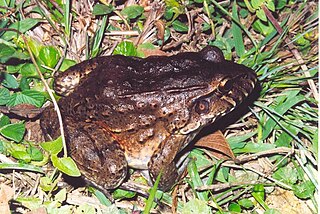
Leptodactylus labyrinthicus is a species of frog in the family Leptodactylidae. Its common names are labyrinth frog, pepper frog, South American pepper frog, and pepper foam frog. This frog is found in central and southeastern Brazil, northeast Argentina, and eastern Paraguay. Earlier reports from Bolivia refer to Leptodactylus vastus, or possibly an unnamed species.
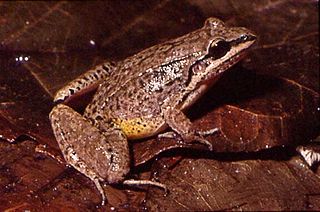
Leptodactylus notoaktites is a species of frog in the family Leptodactylidae. It is endemic to southeastern Brazil and is known from the states of Santa Catarina, Paraná, and São Paulo state. Common name Iporanga white-lipped frog has been coined for it.

Leptodactylus latrans is a species of frog in the family Leptodactylidae. It is native to much of South America east of the Andes, and Trinidad and Tobago. It has many common names, including rana criolla, sapo-rana llanero, butter frog, and lesser foam frog.
Leptodactylus pascoensis is a species of frog in the family Leptodactylidae. It is endemic to Peru where it is only known from two localities ( ). It is an inhabitant of forest floor of the Amazonian flanks of the Andes. Reproduction takes place in foam nests in temporary ponds.
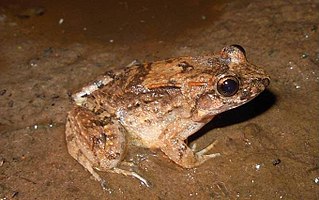
Leptodactylus petersii is a species of frog in the family Leptodactylidae. It is found widely in the Guianas and the Amazon Basin. It has been confused with Leptodactylus podicipinus and Leptodactylus wagneri, complicating the interpretation of older records and accounts.

Leptodactylus podicipinus, sometimes known as the pointedbelly frog, is a species of frog in the family Leptodactylidae. It is found in northern Argentina, Paraguay, Uruguay, Bolivia, and Brazil.

Leptodactylus troglodytes is a species of frogs in the family Leptodactylidae. It is endemic to northeastern Brazil and occurs from northern Minas Gerais and Bahia to Maranhão, Piauí, Ceará, and Rio Grande do Norte. The specific name, troglodytes, refers to its habit of breeding in underground chambers.

Leptodactylus wagneri is a species of frog in the family Leptodactylidae. It is found in northern South America.

Lithodytes is a genus of frogs in the family of Leptodactylidae. It is monotypic, being represented by the single species, Lithodytes lineatus, also commonly known as the gold-striped frog or painted antnest frog. It is found in tropical South America where it lives in humid forests among the leaf litter. These frogs build foam nests at the edge of temporary pools, and the tadpoles develop within these. The frogs also associate with certain leafcutter ants and breed inside their nests without being attacked by the ants.
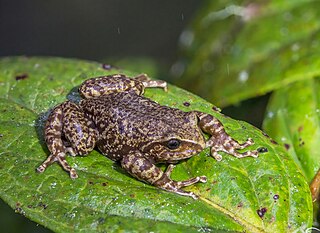
Pristimantis is a very large genus of frogs distributed in the southern Caribbean islands and in Central and South America from Honduras to northern Argentina and southern Brazil. With 596 described species, the genus had more species than any other genus of vertebrate animals. Many of these species genus are endemic to the Northwestern Andean montane forests ecoregion in north-western South America.

Engystomops is a genus of frogs in the family Leptodactylidae. They are known commonly as foam frogs or túngara frogs, though the latter name most commonly refers to Engystomops pustulosus. They are native to the Americas from southern Mexico south to the Amazon Basin.

The Alsodidae are a small family of frogs from South America between Patagonia and southern Brazil. It contains 30 species in three genera. This family, along with several other families, used to be included in the family Leptodactylidae. It was then a subfamily in the family Cycloramphidae, before being recognized as a family first in 2011.

The Leiuperinae are a subfamily of frogs in the family Leptodactylidae. Over 90 species are in five genera. The distribution of this subfamily is from southern Mexico to the Central America and much of South America.



















